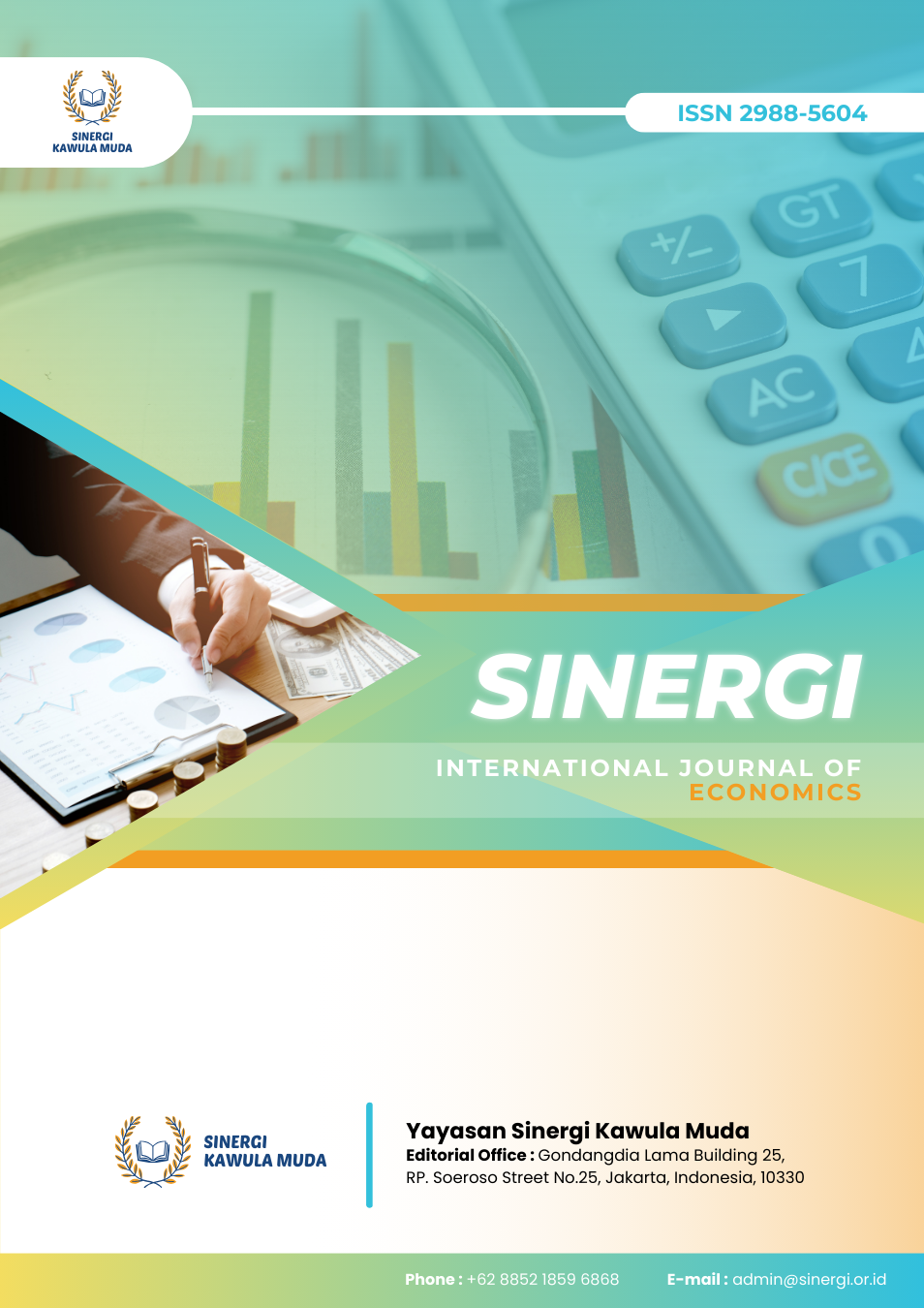Income Taxation and Labor Supply: A Narrative Review of International Findings with Focus on High-Income Economies
DOI:
https://doi.org/10.61194/economics.v2i4.641Keywords:
income taxation, labor supply, tax policy, informal economy, gender and taxation, tax progressivity, fiscal policy designAbstract
This narrative review investigates the impact of income taxation on labor supply across diverse demographic and economic contexts. The study aims to synthesize empirical findings and theoretical insights regarding how tax policy structures influence labor participation. A narrative review methodology was employed, drawing on peer-reviewed literature sourced from Scopus and Google Scholar, guided by targeted keyword strategies and strict inclusion criteria. The review examined studies on tax progressivity, informality, gender disparities, and institutional influences affecting labor supply. Key findings indicate that income taxation exerts complex and varied effects on labor supply. Gendered responses to tax structures, especially under joint taxation regimes, tend to suppress female participation, while separate filing systems improve equity and engagement. Informal labor markets expand when tax compliance is burdensome or perceived as unfair, particularly in developing economies with weak institutional trust. Meanwhile, higher marginal tax rates diminish labor effort among high-income earners, underscoring the importance of balanced progressivity. The review concludes that effective tax policy requires behavioral, institutional, and demographic sensitivity. Tailored reforms can enhance labor market participation and revenue generation without compromising equity. Future research should focus on underexplored regions and emerging labor sectors to guide adaptive, inclusive tax system design for sustainable development.
References
Adair, P. (2020). Études d’impact des politiques de formalisation de l’informel: entreprises versus employés. Mondes en Développement, (190), 57–72. https://doi.org/10.3917/med.190.0057 DOI: https://doi.org/10.3917/med.190.0057
Ayaz, M., Fricke, L., Fuest, C., & Sachs, D. (2023). Who should bear the burden of COVID-19 related fiscal pressure? An optimal income taxation perspective. European Economic Review, 153, 104381. https://doi.org/10.1016/j.euroecorev.2023.104381 DOI: https://doi.org/10.1016/j.euroecorev.2023.104381
Biswas, S., Chakraborty, I., & Hai, R. (2017). Income inequality, tax policy, and economic growth. The Economic Journal, 127(601), 688–727. https://doi.org/10.1111/ej.12485 DOI: https://doi.org/10.1111/ecoj.12485
Borella, M., De Nardi, M., & Yang, F. (2022). Are marriage-related taxes and social security benefits holding back female labour supply? The Review of Economic Studies, 90(1), 102–131. https://doi.org/10.1093/restud/rdac018 DOI: https://doi.org/10.1093/restud/rdac018
Capéau, B., Decoster, A., & Van Houtven, S. (2023). Piecemeal modeling of the effects of joint direct and indirect tax reforms. Public Finance Review, 52(1), 111–149. https://doi.org/10.1177/10911421231198738 DOI: https://doi.org/10.1177/10911421231198738
Casarico, A., & Sommacal, A. (2012). Labor income taxation, human capital, and growth: The role of childcare. Scandinavian Journal of Economics, 114(4), 1182–1207. https://doi.org/10.1111/j.1467-9442.2012.01718.x DOI: https://doi.org/10.1111/j.1467-9442.2012.01718.x
Coelho, M., Davis, A., Klemm, A., & Osorio-Buitron, C. (2024). Gendered taxes: The interaction of tax policy with gender equality. International Tax and Public Finance, 31(5), 1413–1460. https://doi.org/10.1007/s10797-024-09829-w DOI: https://doi.org/10.1007/s10797-024-09829-w
Deng, M. (2024). Inequality, taxation, and sovereign default risk. American Economic Journal: Macroeconomics, 16(2), 217–249. https://doi.org/10.1257/mac.20210133 DOI: https://doi.org/10.1257/mac.20210133
Fu, Z., Wu, L., & Zhuang, Z. (2018). Labor supply, income distribution, and tax progressivity in a search model. The B.E. Journal of Macroeconomics, 19(1). https://doi.org/10.1515/bejm-2017-0185 DOI: https://doi.org/10.1515/bejm-2017-0185
Hanappi, T., & Müllbacher, S. (2013). Tax incentives and family labor supply in Austria. Review of Economics of the Household, 14(4), 961–987. https://doi.org/10.1007/s11150-013-9230-9 DOI: https://doi.org/10.1007/s11150-013-9230-9
Heijdra, B. J., & Mierau, J. O. (2010). Growth effects of consumption and labor-income taxation in an overlapping-generations life-cycle model. Macroeconomic Dynamics, 14(S2), 151–175. https://doi.org/10.1017/s1365100510000337 DOI: https://doi.org/10.1017/S1365100510000337
Jones, J. B., & Li, Y. (2018). The effects of collecting income taxes on Social Security benefits. Journal of Public Economics, 159, 128–145. https://doi.org/10.1016/j.jpubeco.2018.01.004 DOI: https://doi.org/10.1016/j.jpubeco.2018.01.004
Kabátek, J., van Soest, A., & Stancanelli, E. (2014). Income taxation, labour supply and housework: A discrete choice model for French couples. Labour Economics, 27, 30–43. https://doi.org/10.1016/j.labeco.2014.01.004 DOI: https://doi.org/10.1016/j.labeco.2014.01.004
Koyuncu, M., & Turnovsky, S. J. (2016). The dynamics of growth and income inequality under progressive taxation. Journal of Public Economic Theory, 18(4), 560–588. https://doi.org/10.1111/jpet.12191 DOI: https://doi.org/10.1111/jpet.12191
Lyssiotou, P., & Savva, E. (2021). Labor supply responses to income tax free and bracket expansions. Journal of Economic Studies, 49(7), 1225–1239. https://doi.org/10.1108/jes-03-2021-0128 DOI: https://doi.org/10.1108/JES-03-2021-0128
McKay, A., Pirttilä, J., & Schimanski, C. (2023). The tax elasticity of formal work in Sub-Saharan African countries. The Journal of Development Studies, 60(2), 217–244. https://doi.org/10.1080/00220388.2023.2279477 DOI: https://doi.org/10.1080/00220388.2023.2279477
Nesterova, K. (2024). Estimating the effect of progressive personal income tax schedule for Russia in a global CGE-OLG model. Journal of Tax Reform, 10(2), 334–354. https://doi.org/10.15826/jtr.2024.10.2.172 DOI: https://doi.org/10.15826/jtr.2024.10.2.172
Nuraini, F., Wahjoedi, W., Rahmawati, F., & Fitriyah, A. (2024). Exploring the Pathways of Intention to Work in the Agribusiness Sector within a Green Economy Paradigm. The Eurasia Proceedings of Educational and Social Sciences, 37, 88–103. https://doi.org/10.55549/epess.862 DOI: https://doi.org/10.55549/epess.862
Simonovits, A. (2013). Does higher tax morale imply higher optimal labor income tax rate? Danube, 4(2), 97–114. https://doi.org/10.2478/danb-2013-0005 DOI: https://doi.org/10.2478/danb-2013-0005
Simutina, N., & Leventov, N. (2019). Informal business activity in the Russian Federation: Keep not estimate. In Digital Economy: Complexity and Variety vs. Rationality (pp. 196–204). Springer. https://doi.org/10.1007/978-3-030-18553-4_25 DOI: https://doi.org/10.1007/978-3-030-18553-4_25
Tikoudis, I., Verhoef, E. T., & van Ommeren, J. (2015). On revenue recycling and the welfare effects of second-best congestion pricing in a monocentric city. Journal of Urban Economics, 89, 32–47. https://doi.org/10.1016/j.jue.2015.06.004 DOI: https://doi.org/10.1016/j.jue.2015.06.004
Villamaina, L., & Acciari, P. (2024). Taxation and labor supply decisions: Impact of the earned income tax credit in Italy. International Journal of Manpower. https://doi.org/10.1108/ijm-12-2023-0709 DOI: https://doi.org/10.1108/IJM-12-2023-0709






